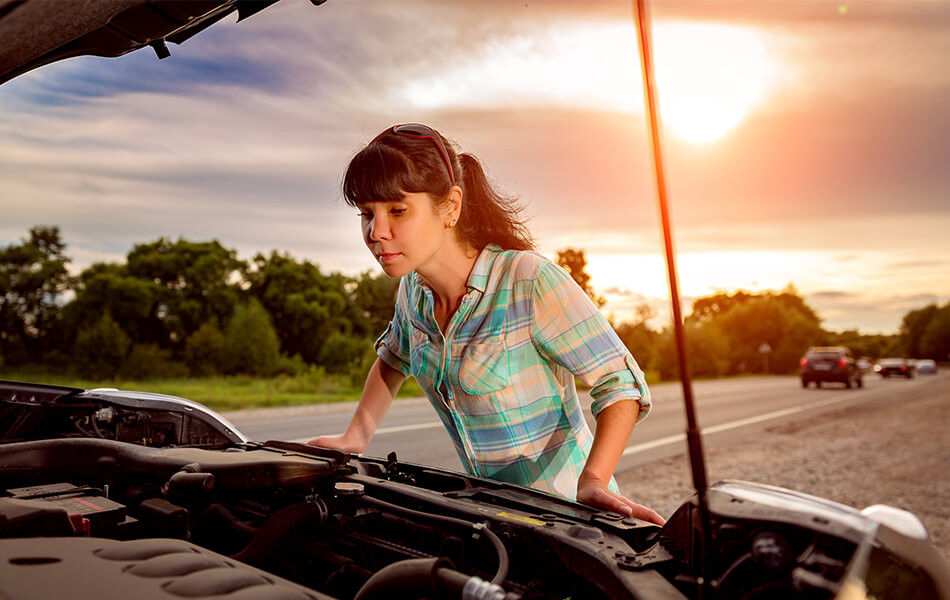How often do you check your car’s engine temperature gauge? Unfortunately, many of us do not check it enough, and by the time that tell-tale smoke comes billowing out from under the hood, the engine has already begun to seriously overheat.
Overheating can damage an engine very quickly, so if it happens to you, it needs to be dealt with quickly (and hopefully, before the smoking starts). Here are the steps you should follow to cool your engine down if it overheats ...
Start the Cooling Process Immediately.
If you happen to notice that your gauge needle has moved from the “safe zone”—in the middle, or between 195 and 220 degrees farenheit—DON’T ignore it! (Some vehicles use a high temperature warning light, instead, so you will have to pay attention to your car’s setup.) Air conditioning can sometimes lend itself to overheating, so start by turning that off. If the needle is still not moving back toward the middle (or the warning light is not turning off), try blasting the heater. This will hopefully divert some heat from the engine into the interior of the vehicle.
If neither of these steps succeeds in cooling down your engine, proceed to the next step ...
Stop Driving!
If the temperature keeps rising and/or there is smoke or steam coming out from under the hood, it’s time to pull over. Immediately. Continuing to drive with an overheated engine can not only damage the engine and your car, but also YOU! (Plus, it’s pretty impossible to see with all of that smog clouding up your windshield.) Instead, find a safe place to pull over and turn off the engine.
Wait For The Engine To Cool.
Now, this is crucial—wait for the engine to cool down a bit BEFORE you go around to open the hood. (Although if you are able to open it with a lever inside the car, that’s okay.) If steam was coming out, wait for the steaming to stop. You mainly just want to avoid being injured by hot, smoky steam.
Check The Coolant Level.
You can do this just by looking. First, locate the coolant reservoir—usually a plastic, translucent container on the right or left front of the engine compartment. Normally, the liquid level in the coolant reservoir is between the minimum and maximum lines. If you see that the liquid is below the minimum fill line (or you can’t see it at all), you are probably low on coolant. That means that your next step will be to check and refill the coolant in the radiator.
WARNING: this part can be very dangerous, as the coolant remaining in the radiator is under pressure and can cause severe burns! If you are not comfortable doing this step, call a mechanic or roadside assistance.
Wait for the engine to cool significantly for several more minutes, then start by carefully loosening the radiator cap. Use a cloth on top of the radiator cap to protect your hand, and keep your face out of the way. Slowly turn the radiator cap to the first notch, wait a few seconds, press down on the cap, and then unscrew it all the way. Again, you will want to protect yourself from escaping steam that will still be very hot.
Replenish The Coolant.
Engines run best on a 50/50 mixture of antifreeze and water, which is why you should always carry a bottle of that mixture in your trunk, just in case. If you don’t have access to antifreeze, you can use plain water as a TEMPORARY solution. (Make sure that the radiator is cool before adding cold antifreeze or water, as it can cause cracks in a radiator that is still hot.)
Fill the radiator up to the neck with the coolant solution. Then, squeeze the large, black hose at the top several times to remove air, and continue to fill the radiator as necessary. Replace the radiator cap, securing it snugly. Finally, remove the cap from the coolant reservoir and fill it about half way with antifreeze, then replace the cap.
Drive To The Nearest Repair Shop.
Whether or not you have fixed the problem, it is always best to have a professional check out your car after an escalated overheating incident. They will be able to tell you how much (if any) damage has been done to the engine, if anything is leaking, etc. It’s always better to be safe than sorry! (Also, remember to check that coolant reservoir often!)
Situations like overheated engines are never fun, but the more you understand what’s going on underneath the hood and what you can do to fix it, the better off your car will be.
From all of us at Quick-Set, drive carefully out there!

